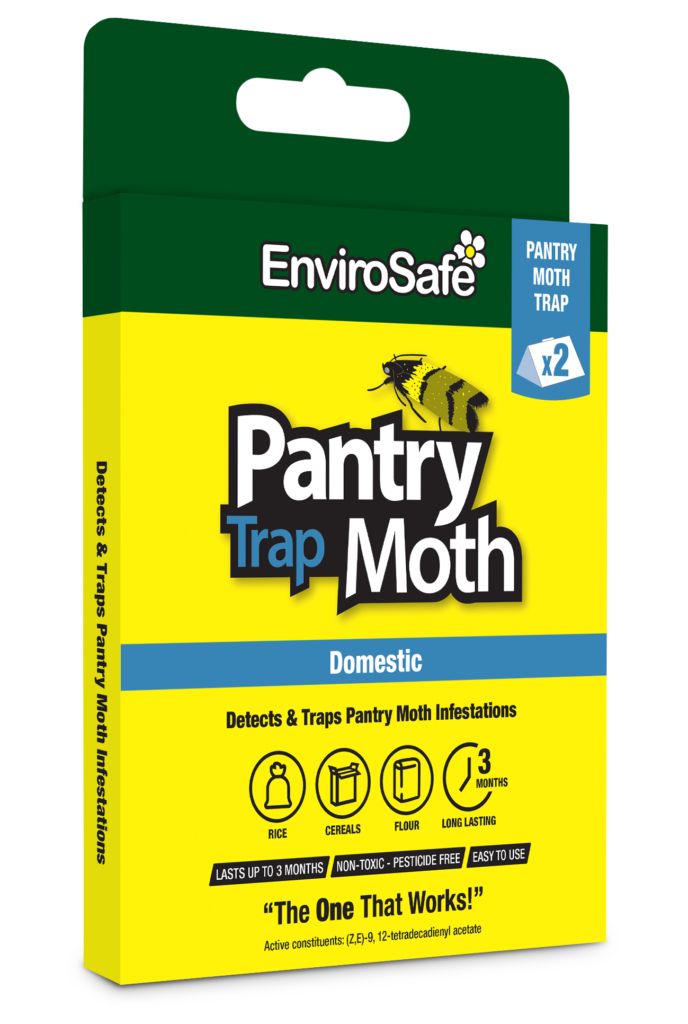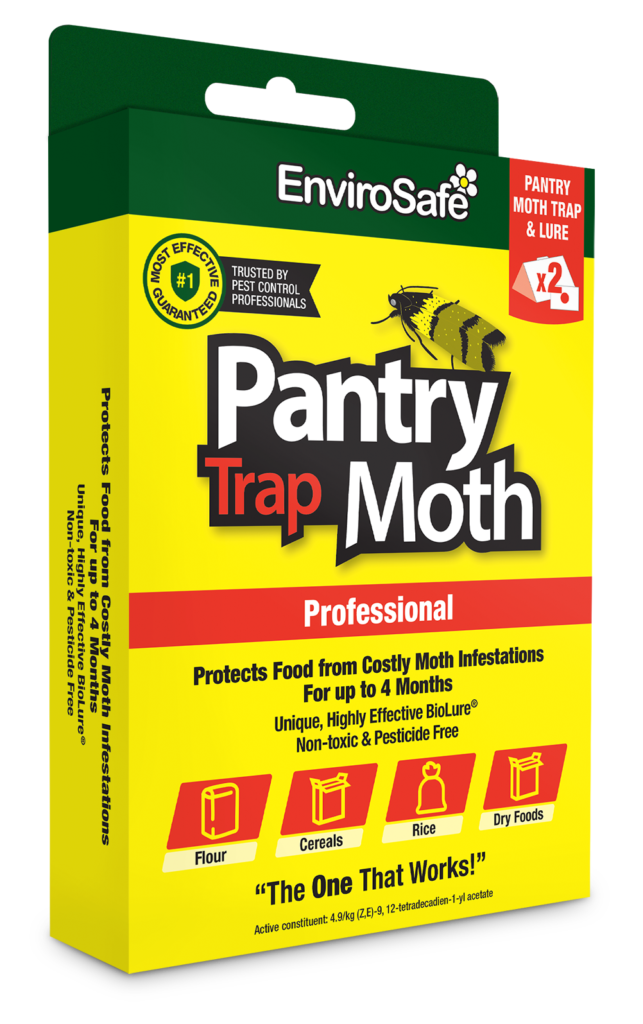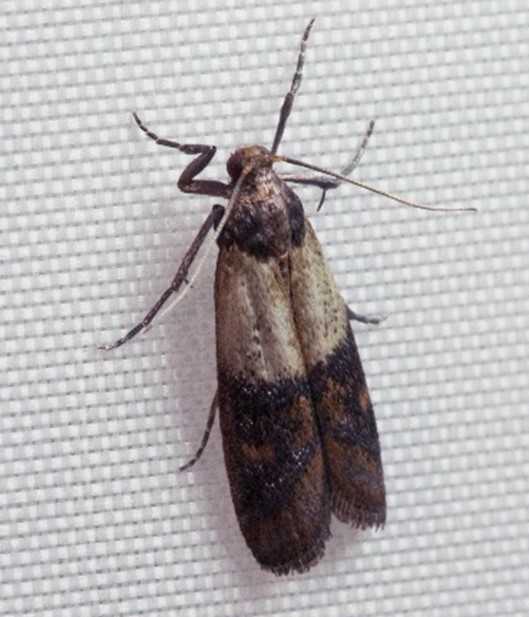Do you have uninvited guests in your breakfast?
If you’ve found a bit of silk or webbing stuck to the inside of your cereal packaging, you’ve got pantry moths! It’s not the actual pantry moths that eat your dried food products, but their larvae. The adult moths are short-lived and do not feed, but you might see them fluttering about in your pantry or kitchen at night, or flying in front of the television, attracted to the light. The females lay their eggs near a food source, and when the tiny larvae hatch out, they can enter food products through any small hole in the packaging. The older larvae have strong chewing mouthparts which means that they can sometimes chew their way through thin plastic or paper packaging into unopened foods. Once there, they help themselves to your delicious cereal, flour or other dried goods and leave their mess behind.
When the larvae have molted a number of times and finished feeding, they leave the food to pupate in the crevices of packaging or pantry shelving. They may also climb the wall to the corner where it meets the ceiling and hang their cocoons by a silken thread.
The adult moths emerge from the cocoons, find a mate and lay eggs to get the next generation started. The period of time that the life cycle takes depends on temperature, taking two – six months in temperate zones and three to four weeks in hot climates. In cold climates, larvae may pause their development over winter, then pupate and emerge as adults to start the next generation in spring.
How do I identify pantry moths?
By far the most common pantry moth species is known as the Indianmeal Moth (Plodia interpunctella). This is a small moth, 8-10mm in length. The wings, when viewed from above, have a two-toned appearance, with the section closest to the head being whitish-grey, and the outer two thirds being reddish-brown with a copper luster. The larvae are off-white with a brown head and several pairs of legs and can grow to 12mm in length. The eggs are less than half a millimetre long, so they are difficult to see and often go unnoticed.
Where do they come from?
The most likely way for pantry moths to enter your home is not from the wild outside, but as larvae packaged inside your groceries. Bulk dry food handling sites like mills, warehouses, markets, pet stores, seed companies and even supermarkets can find controlling the pest to be a huge challenge, so larvae can end up being packaged along with the food, which is then purchased and brought to your home.
What foods do pantry moth infest?
Pantry moths can infest a wide range of dry food products including cereal, flour, pasta, rice, beans, oatmeal, nuts, spices and dried fruits. Like many of us, they are even strongly attracted to chocolate! They can also be found in non-food items such as dried flowers, bird seed and dry dog food.

(Photo by Markus Spiske from Pexels)
Control of Pantry Moths
Prevention and sanitation are the best ways to protect against pantry pests. Insecticides are of limited use as they are generally not recommended around food, which is where the pantry moths are found. Here are some tips to prevent infestations in the home, thereby minimizing food wastage and saving money:
- Before purchase, check for rips or tears in packaging where pests may enter
- At home, store opened packages in air-tight, insect-proof containers
- Use proper stock rotation and cook with the oldest products first to ensure freshness
- Where possible, refrigerate those foods that are used less often
- Regularly wipe away spills and sweep up crumbs in your food storage areas
- Vacuum cracks and crevices where crumbs can accumulate, and insects can shelter
- Set a Pantry Moth Trap to monitor for moths and catch infestations before they spread
Which Pantry Moths Trap should I use?
EnviroSafe provides two quality Pantry Moth Traps to choose from: Domestic and Professional.

The Domestic trap has ease of use and convenience in mind. The lure is already mixed into the glue coating the inside of the trap to catch the moths. Setting the trap is extremely easy. Simply peel away the cover from the sticky trap and fold to form a tent shape. Place one or two traps in your pantry cupboard, on the shelves where you store your dry foods, and replace every 3 months.
The Professional trap uses patented BioLure technology that releases the attractant at a slow and steady rate for the life of the trap. The lure is packaged into a separate sachet that needs to be attached to the glue on the trap before folding and placing the trap. This trap design ensures a longer period of strong lure emission (up to 4 months) and is more effective for the larger home pantry where more bulk dry goods may be stored, or for professional kitchens.

How do I get rid of a pantry moths infestation?
When moths are found on your Pantry Moth Trap, it is time to look for the source of the infestation. If left untreated, the infestation will spread to more of your stored foodstuffs and turn into a bigger problem.
- Get everything out of the pantry and vacuum the shelves and crevices to remove any sheltering moths, larvae or cocoons.
- Thoroughly wash your pantry shelves with hot, soapy water, then wipe down well with 50:50 warm water and white vinegar to kill any unseen eggs.
- Wash and dry all of your dry food storage containers, even if they don’t look infested, as there may be pantry moth eggs on them.
- Place any opened dry goods, which may contain eggs and larvae, into a kitchen tidy bag and put the bag in your outside bin. If you have used your inside bin for disposal, you should clean this down as well.
- Check for evidence of larvae in any other unopened dry food packages which have rips or holes where larvae may have gained access.
It may be difficult to completely eradicate pantry moth infestations, and there is always a chance that the pest will be re-introduced into your home via your groceries. Therefore, setting that Pantry Moth Trap will help you monitor for the pest and detect infestations early making it easier to keep those uninvited breakfast guests away!


